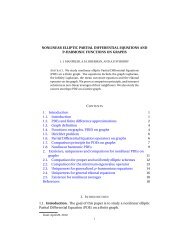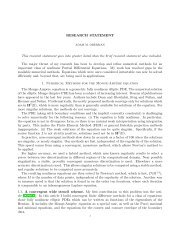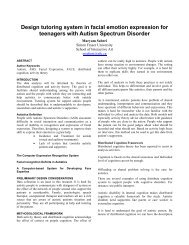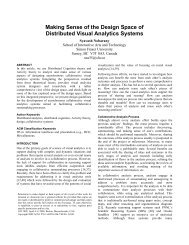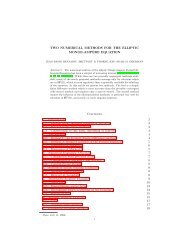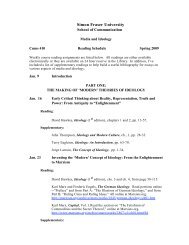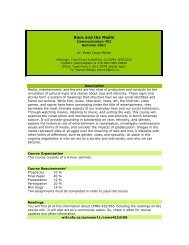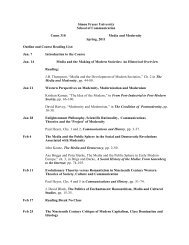Boyd Convex Optimization book - SFU Wiki
Boyd Convex Optimization book - SFU Wiki
Boyd Convex Optimization book - SFU Wiki
You also want an ePaper? Increase the reach of your titles
YUMPU automatically turns print PDFs into web optimized ePapers that Google loves.
296 6 Approximation and fitting<br />
function. But the shape of the penalty function has a large effect on the solution of<br />
the penalty function approximation problem. Roughly speaking, φ(u) is a measure<br />
of our dislike of a residual of value u. If φ is very small (or even zero) for small<br />
values of u, it means we care very little (or not at all) if residuals have these values.<br />
If φ(u) grows rapidly as u becomes large, it means we have a strong dislike for<br />
large residuals; if φ becomes infinite outside some interval, it means that residuals<br />
outside the interval are unacceptable. This simple interpretation gives insight into<br />
the solution of a penalty function approximation problem, as well as guidelines for<br />
choosing a penalty function.<br />
As an example, let us compare l 1 -norm and l 2 -norm approximation, associated<br />
with the penalty functions φ 1 (u) = |u| and φ 2 (u) = u 2 , respectively. For<br />
|u| = 1, the two penalty functions assign the same penalty. For small u we have<br />
φ 1 (u) ≫ φ 2 (u), so l 1 -norm approximation puts relatively larger emphasis on small<br />
residuals compared to l 2 -norm approximation. For large u we have φ 2 (u) ≫ φ 1 (u),<br />
so l 1 -norm approximation puts less weight on large residuals, compared to l 2 -norm<br />
approximation. This difference in relative weightings for small and large residuals<br />
is reflected in the solutions of the associated approximation problems. The amplitude<br />
distribution of the optimal residual for the l 1 -norm approximation problem<br />
will tend to have more zero and very small residuals, compared to the l 2 -norm approximation<br />
solution. In contrast, the l 2 -norm solution will tend to have relatively<br />
fewer large residuals (since large residuals incur a much larger penalty in l 2 -norm<br />
approximation than in l 1 -norm approximation).<br />
Example<br />
An example will illustrate these ideas. We take a matrix A ∈ R 100×30 and vector<br />
b ∈ R 100 (chosen at random, but the results are typical), and compute the l 1 -norm<br />
and l 2 -norm approximate solutions of Ax ≈ b, as well as the penalty function<br />
approximations with a deadzone-linear penalty (with a = 0.5) and log barrier<br />
penalty (with a = 1). Figure 6.2 shows the four associated penalty functions,<br />
and the amplitude distributions of the optimal residuals for these four penalty<br />
approximations. From the plots of the penalty functions we note that<br />
• The l 1 -norm penalty puts the most weight on small residuals and the least<br />
weight on large residuals.<br />
• The l 2 -norm penalty puts very small weight on small residuals, but strong<br />
weight on large residuals.<br />
• The deadzone-linear penalty function puts no weight on residuals smaller<br />
than 0.5, and relatively little weight on large residuals.<br />
• The log barrier penalty puts weight very much like the l 2 -norm penalty for<br />
small residuals, but puts very strong weight on residuals larger than around<br />
0.8, and infinite weight on residuals larger than 1.<br />
Several features are clear from the amplitude distributions:<br />
• For the l 1 -optimal solution, many residuals are either zero or very small. The<br />
l 1 -optimal solution also has relatively more large residuals.



